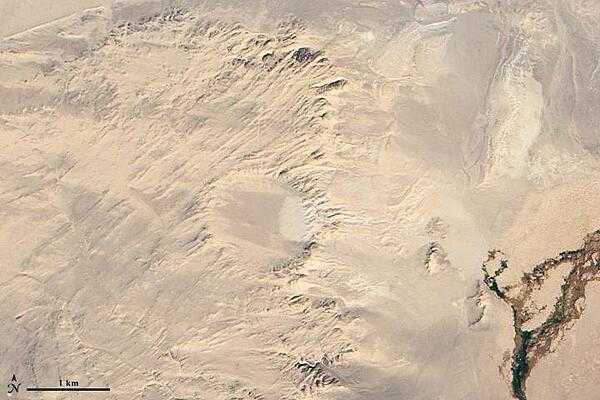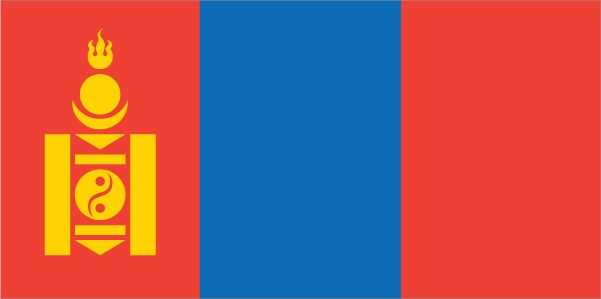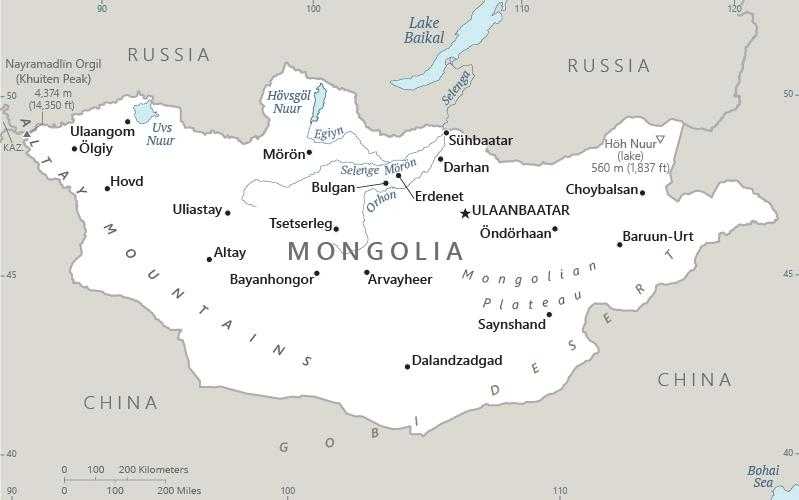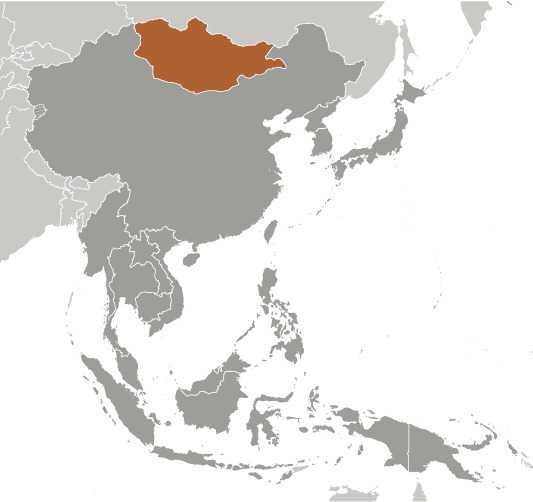Introduction
Background
The peoples of Mongolia have a long history under a number of nomadic empires dating back to the Xiongnu in the 4th century B.C., and the name Mongol goes back to at least the 11th century A.D. The most famous Mongol, TEMÜÜJIN (aka Genghis Khan), emerged as the ruler of all Mongols in the early 1200s. By the time of his death in 1227, he had created through conquest a Mongol Empire that extended across much of Eurasia. His descendants, including ÖGÖDEI and KHUBILAI (aka Kublai Khan), continued to conquer Eastern Europe, the Middle East, and the rest of China, where KHUBILAI established the Yuan Dynasty in the 1270s. The Mongols attempted to invade Japan and Java before their empire broke apart in the 14th century. In the 17th century, Mongolia fell under the rule of the Manchus of the Chinese Qing Dynasty. After Manchu rule collapsed in 1911, Mongolia declared independence, finally winning it in 1921 with help from the Soviet Union. Mongolia became a socialist state (the Mongolian People’s Republic) in 1924. Until the collapse of the Soviet Union in 1989, Mongolia was a Soviet satellite state and relied heavily on economic, military, and political assistance from Moscow. The period was also marked by purges, political repression, economic stagnation, and tensions with China.
Mongolia peacefully transitioned to an independent democracy in 1990. In 1992, it adopted a new constitution and established a free-market economy. Since the country's transition, it has conducted a series of successful presidential and legislative elections. Throughout the period, the ex-communist Mongolian People's Revolutionary Party -- which took the name Mongolian People’s Party (MPP) in 2010 -- has competed for political power with the Democratic Party and several other smaller parties. For most of its democratic history, Mongolia has had a divided government, with the presidency and the parliamentary majority held by different parties but that changed in 2021, when the MPP won the presidency after having secured a supermajority in parliament in 2020. Mongolia’s June 2021 presidential election delivered a decisive victory for MPP candidate Ukhnaagiin KHURELSUKH.
Mongolia maintains close cultural, political, and military ties with Russia, while China is its largest economic partner. Mongolia’s foreign relations are focused on preserving its autonomy by balancing relations with China and Russia, as well as its other major partners, Japan, South Korea, and the US.
Visit the Definitions and Notes page to view a description of each topic.
Geography
Location
Northern Asia, between China and Russia
Geographic coordinates
46 00 N, 105 00 E
Map references
Asia
Area - comparative
slightly smaller than Alaska; more than twice the size of Texas
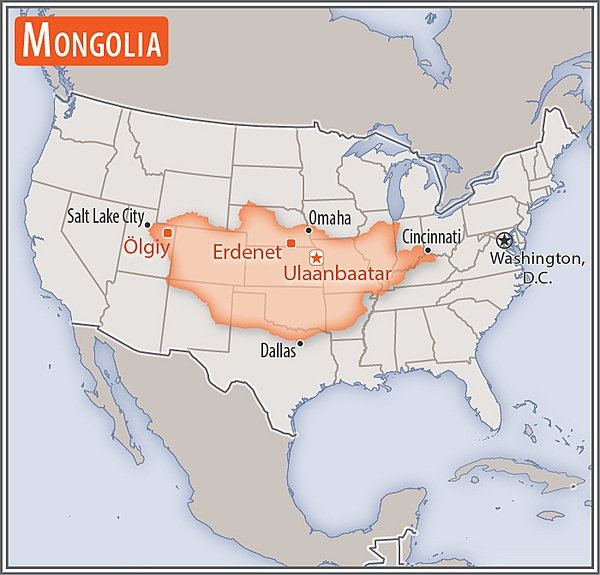
Land boundaries
total: 8,082 km
border countries (2): China 4,630 km; Russia 3,452 km
Coastline
0 km (landlocked)
Maritime claims
none (landlocked)
Climate
desert; continental (large daily and seasonal temperature ranges)
Terrain
vast semidesert and desert plains, grassy steppe, mountains in west and southwest; Gobi Desert in south-central
Elevation
highest point: Nayramadlin Orgil (Khuiten Peak) 4,374 m
lowest point: Hoh Nuur 560 m
mean elevation: 1,528 m
Natural resources
oil, coal, copper, molybdenum, tungsten, phosphates, tin, nickel, zinc, fluorspar, gold, silver, iron
Land use
agricultural land: 73% (2018 est.)
arable land: 0.4% (2018 est.)
permanent crops: 0% (2018 est.)
permanent pasture: 72.6% (2018 est.)
forest: 7% (2018 est.)
other: 20% (2018 est.)
Irrigated land
602 sq km (2020)
Major lakes (area sq km)
fresh water lake(s): Hovsgol Nuur - 2,620 sq km; Har Us Nuur - 1,760 sq km;
salt water lake(s): Uvs Nuur - 3,350 sq km; Hyargas Nuur - 1,360 sq km
Major rivers (by length in km)
Amur (shared with China [s] and Russia [m]) - 4,444 km
note – [s] after country name indicates river source; [m] after country name indicates river mouth
Population distribution
sparsely distributed population throughout the country; the capital of Ulaanbaatar and the northern city of Darhan support the highest population densities
Natural hazards
dust storms; grassland and forest fires; drought; "zud," which is harsh winter conditions
Geography - note
landlocked; strategic location between China and Russia
People and Society
Population
total: 3,281,676
male: 1,595,596
female: 1,686,080 (2024 est.)
comparison rankings: female 134; male 137; total 134
Nationality
noun: Mongolian(s)
adjective: Mongolian
Ethnic groups
Khalkh 83.8%, Kazak 3.8%, Durvud 2.6%, Bayad 2%, Buriad 1.4%, Zakhchin 1.2%, Dariganga 1.1%, other 4.1% (2020 est.)
Languages
Mongolian 90% (official) (Khalkha dialect is predominant), Turkic, Russian (1999)
major-language sample(s):
Дэлхийн баримтат ном, үндсэн мэдээллийн зайлшгүй эх сурвалж. (Mongolian)
The World Factbook, the indispensable source for basic information.
Religions
Buddhist 51.7%, Muslim 3.2%, Shamanist 2.5%, Christian 1.3%, other 0.7%, none 40.6% (2020 est.)
Age structure
0-14 years: 25.7% (male 429,867/female 412,943)
15-64 years: 68.4% (male 1,087,487/female 1,156,547)
65 years and over: 5.9% (2024 est.) (male 78,242/female 116,590)
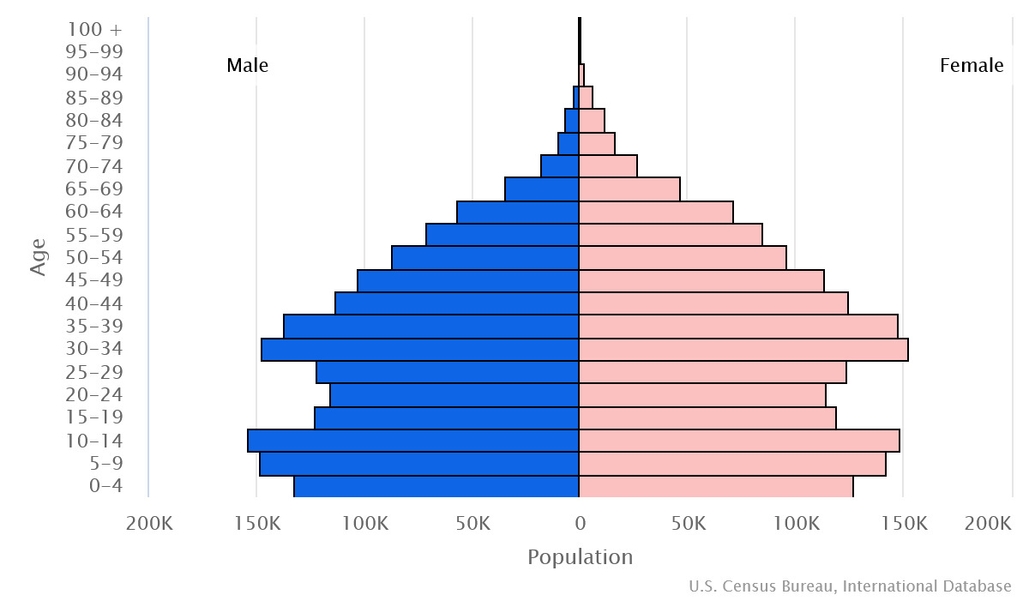
Dependency ratios
total dependency ratio: 58.4
youth dependency ratio: 51.4
elderly dependency ratio: 7
potential support ratio: 14.3 (2021 est.)
Median age
total: 31.5 years (2024 est.)
male: 30.1 years
female: 32.8 years
comparison ranking: total 126
Population distribution
sparsely distributed population throughout the country; the capital of Ulaanbaatar and the northern city of Darhan support the highest population densities
Urbanization
urban population: 69.1% of total population (2023)
rate of urbanization: 1.4% annual rate of change (2020-25 est.)
Major urban areas - population
1.673 million ULAANBAATAR (capital) (2023)
Sex ratio
at birth: 1.05 male(s)/female
0-14 years: 1.04 male(s)/female
15-64 years: 0.94 male(s)/female
65 years and over: 0.67 male(s)/female
total population: 0.95 male(s)/female (2024 est.)
Mother's mean age at first birth
20.5 years (2008 est.)
note: data represents median age at first birth among women 20-24
Infant mortality rate
total: 19.4 deaths/1,000 live births (2024 est.)
male: 22.4 deaths/1,000 live births
female: 16.2 deaths/1,000 live births
comparison ranking: total 78
Life expectancy at birth
total population: 71.9 years (2024 est.)
male: 67.8 years
female: 76.3 years
comparison ranking: total population 168
Gross reproduction rate
0.91 (2024 est.)
Contraceptive prevalence rate
48.1% (2018)
Drinking water source
improved: urban: 98.4% of population
rural: 64.2% of population
total: 87.6% of population
unimproved: urban: 1.6% of population
rural: 35.8% of population
total: 12.4% of population (2020 est.)
Current health expenditure
4.9% of GDP (2020)
Physician density
3.85 physicians/1,000 population (2018)
Hospital bed density
8 beds/1,000 population (2017)
Sanitation facility access
improved: urban: 97.4% of population
rural: 69.9% of population
total: 88.8% of population
unimproved: urban: 2.6% of population
rural: 30.1% of population
total: 11.2% of population (2020 est.)
Alcohol consumption per capita
total: 5.46 liters of pure alcohol (2019 est.)
beer: 2.18 liters of pure alcohol (2019 est.)
wine: 1.46 liters of pure alcohol (2019 est.)
spirits: 1.82 liters of pure alcohol (2019 est.)
other alcohols: 0 liters of pure alcohol (2019 est.)
comparison ranking: total 80
Tobacco use
total: 29.4% (2020 est.)
male: 51.7% (2020 est.)
female: 7.1% (2020 est.)
comparison ranking: total 33
Currently married women (ages 15-49)
58.9% (2023 est.)
Child marriage
women married by age 15: 0.9%
women married by age 18: 12%
men married by age 18: 2.1% (2018 est.)
Literacy
definition: age 15 and over can read and write
total population: 99.2%
male: 99.1%
female: 99.2% (2020)
School life expectancy (primary to tertiary education)
total: 15 years
male: 14 years
female: 16 years (2019)
Environment
Environment - current issues
limited natural freshwater resources in some areas; the burning of soft coal in power plants and the lack of enforcement of environmental laws leads to air pollution in Ulaanbaatar; deforestation and overgrazing increase soil erosion from wind and rain; water pollution; desertification and mining activities have a deleterious effect on the environment
Environment - international agreements
party to: Antarctic Treaty, Biodiversity, Climate Change, Climate Change-Kyoto Protocol, Climate Change-Paris Agreement, Comprehensive Nuclear Test Ban, Desertification, Endangered Species, Environmental Modification, Hazardous Wastes, Law of the Sea, Nuclear Test Ban, Ozone Layer Protection, Ship Pollution, Wetlands, Whaling
signed, but not ratified: none of the selected agreements
Climate
desert; continental (large daily and seasonal temperature ranges)
Land use
agricultural land: 73% (2018 est.)
arable land: 0.4% (2018 est.)
permanent crops: 0% (2018 est.)
permanent pasture: 72.6% (2018 est.)
forest: 7% (2018 est.)
other: 20% (2018 est.)
Urbanization
urban population: 69.1% of total population (2023)
rate of urbanization: 1.4% annual rate of change (2020-25 est.)
Air pollutants
particulate matter emissions: 41.3 micrograms per cubic meter (2019 est.)
carbon dioxide emissions: 25.37 megatons (2016 est.)
methane emissions: 13.72 megatons (2020 est.)
Waste and recycling
municipal solid waste generated annually: 2.9 million tons (2016 est.)
Major lakes (area sq km)
fresh water lake(s): Hovsgol Nuur - 2,620 sq km; Har Us Nuur - 1,760 sq km;
salt water lake(s): Uvs Nuur - 3,350 sq km; Hyargas Nuur - 1,360 sq km
Major rivers (by length in km)
Amur (shared with China [s] and Russia [m]) - 4,444 km
note – [s] after country name indicates river source; [m] after country name indicates river mouth
Total water withdrawal
municipal: 50 million cubic meters (2020 est.)
industrial: 170 million cubic meters (2020 est.)
agricultural: 250 million cubic meters (2020 est.)
Total renewable water resources
34.8 billion cubic meters (2020 est.)
Government
Country name
conventional long form: none
conventional short form: Mongolia
local long form: none
local short form: Mongol Uls
former: Outer Mongolia, Mongolian People's Republic
etymology: the name means "Land of the Mongols" in Latin; the Mongolian name Mongol Uls translates as "Mongol State"
Government type
semi-presidential republic
Capital
name: Ulaanbaatar
geographic coordinates: 47 55 N, 106 55 E
time difference: UTC+8 (13 hours ahead of Washington, DC, during Standard Time)
daylight saving time: +1hr, begins last Saturday in March; ends last Saturday in September
time zone note: Mongolia has two time zones - Ulaanbaatar Time (8 hours in advance of UTC) and Hovd Time (7 hours in advance of UTC)
etymology: the name means "red hero" in Mongolian and honors national hero Damdin SUKHBAATAR, leader of the partisan army that with Soviet Red Army help, liberated Mongolia from Chinese occupation in the early 1920s
Administrative divisions
21 provinces (aymguud, singular - aymag) and 1 municipality* (singular - hot); Arhangay, Bayanhongor, Bayan-Olgiy, Bulgan, Darhan-Uul, Dornod, Dornogovi, Dundgovi, Dzavhan (Zavkhan), Govi-Altay, Govisumber, Hentiy, Hovd, Hovsgol, Omnogovi, Orhon, Ovorhangay, Selenge, Suhbaatar, Tov, Ulaanbaatar*, Uvs
Independence
29 December 1911 (independence declared from China; in actuality, autonomy attained); 11 July 1921 (from China)
National holiday
Naadam (games) holiday (commemorates independence from China in the 1921 Revolution), 11-15 July; Constitution Day (marks the date that the Mongolian People's Republic was created under a new constitution), 26 November (1924)
Constitution
history: several previous; latest adopted 13 January 1992, effective 12 February 1992
amendments: proposed by the State Great Hural, by the president of the republic, by the government, or by petition submitted to the State Great Hural by the Constitutional Court; conducting referenda on proposed amendments requires at least two-thirds majority vote of the State Great Hural; passage of amendments by the State Great Hural requires at least three-quarters majority vote; passage by referendum requires majority participation of qualified voters and a majority of votes; amended 1999, 2000, 2019, 2023; note - an amendment passed in a referendum held in May 2023 increased the seats in the State Great Hural from 76 to 126
Legal system
civil law system influenced by Soviet and Romano-Germanic legal systems; constitution ambiguous on judicial review of legislative acts
International law organization participation
has not submitted an ICJ jurisdiction declaration; accepts ICCt jurisdiction
Citizenship
citizenship by birth: no
citizenship by descent only: both parents must be citizens of Mongolia; one parent if born within Mongolia
dual citizenship recognized: no
residency requirement for naturalization: 5 years
Suffrage
18 years of age; universal
Executive branch
chief of state: President Ukhnaagiin KHURELSUKH (since 25 June 2021)
head of government: Prime Minister Luvsannamsrai OYUN-ERDENE (since 27 January 2021)
cabinet: directly appointed by the prime minister following a constitutional amendment ratified in November 2019; prior to the amendment, the cabinet was nominated by the prime minister in consultation with the president and confirmed by the State Great Hural (parliament)
elections/appointments: presidential candidates nominated by political parties represented in the State Great Hural and directly elected by simple majority popular vote for one 6-year term; election last held on 9 June 2021 (next to be held in 2027); following legislative elections, the leader of the majority party or majority coalition is usually elected prime minister by the State Great Hural
election results: 2021: Ukhnaagiin KHURELSUKH elected president in first round; percent of vote - Ukhnaagiin KHURELSUKH (MPP) 68%, Dangaasuren ENKHBAT (RPEC) 20.1%, Sodnomzundui ERDENE (DP) 6%
Legislative branch
description: unicameral State Great Hural or Ulsyn Ikh Khural (126 seats; 78 members directly elected in a selected constituency by simple majority vote and 48 members directly elected by proportional representation vote; members serve 4-year terms); note - a constitutional referendum passed in May 2023 increased the number of seats from 76 to 126
elections: last held on 28 June 2024 (next to be held June 2028)
election results: percent of vote by party - MPP 35.0%, DP 30.1%, HUN Party 10.4%, National Coalition 5.2%, CWGP 5%, other 14.3%; seats by party - MPP 68, DP 42, HUN Party 8, National Coalition 4, CWGP 4; composition - N/A
Judicial branch
highest court(s): Supreme Court (consists of the Chief Justice and 24 judges organized into civil, criminal, and administrative chambers); Constitutional Court or Tsets (consists of the chairman and 8 members)
judge selection and term of office: Supreme Court chief justice and judges appointed by the president upon recommendation by the General Council of Courts - a 14-member body of judges and judicial officials - to the State Great Hural; appointment is for life; chairman of the Constitutional Court elected from among its members; members appointed from nominations by the State Great Hural - 3 each by the president, the State Great Hural, and the Supreme Court; appointment is 6 years; chairmanship limited to a single renewable 3-year term
subordinate courts: aimag (provincial) and capital city appellate courts; soum, inter-soum, and district courts; Administrative Cases Courts
Political parties and leaders
Democratic Party or DP [ Luvsannyamyn GANTOMOR]
Mongolian People's Party or MPP [ Luvsannamsrain OYUN-ERDENE]
National Coalition [Nyamtaishiriin NOMTOIBAYAR]
National Labor Party or HUN [Togmidyn DORJKHAND]
Civil Will-Green Party or CWGP [Batyn BATBAATAR]
National Coalition consists of the Mongolian Green Party (MGP) and the Mongolian National Democratic Party (MNDP)
International organization participation
ADB, ARF, CD, CICA, CP, EBRD, EITI (compliant country), FAO, G-77, IAEA, IBRD, ICAO, ICC (NGOs), ICCt, ICRM, IDA, IFAD, IFC, IFRCS, ILO, IMF, IMO, IMSO, Interpol, IOC, IOM, IPU, ISO, ITSO, ITU, ITUC, MIGA, MINURSO, MONUSCO, NAM, OPCW, OSCE, SCO (observer), UN, UNAMID, UNCTAD, UNESCO, UNIDO, UNISFA, UNMISS, UNWTO, UPU, WCO, WHO, WIPO, WMO, WTO
Diplomatic representation in the US
chief of mission: Ambassador BATBAYAR Ulziidelger (since 1 December 2021)
chancery: 2833 M Street NW, Washington, DC 20007
telephone: [1] (202) 333-7117
FAX: [1] (202) 298-9227
email address and website:
washington@mfa.gov.mn
http://mongolianembassy.us/
consulate(s) general: New York, San Francisco
Diplomatic representation from the US
chief of mission: Ambassador Richard L. BUANGAN (since November 2022)
embassy: Denver Street #3, 11th Micro-District, Ulaanbaatar 14190
mailing address: 4410 Ulaanbaatar Place, Washington DC 20521-4410
telephone: [976] 7007-6001
FAX: [976] 7007-6174
email address and website:
UlaanbaatarACS@state.gov
https://mn.usembassy.gov/
Flag description
three, equal vertical bands of red (hoist side), blue, and red; centered on the hoist-side red band in yellow is the national emblem ("soyombo" - a columnar arrangement of abstract and geometric representation for fire, sun, moon, earth, water, and the yin-yang symbol); blue represents the sky, red symbolizes progress and prosperity
National symbol(s)
soyombo emblem; national colors: red, blue, yellow
National anthem
name: "Mongol ulsyn toriin duulal" (National Anthem of Mongolia)
lyrics/music: Tsendiin DAMDINSUREN/Bilegiin DAMDINSUREN and Luvsanjamts MURJORJ
note: music adopted 1950, lyrics adopted 2006; lyrics altered on numerous occasions
National heritage
total World Heritage Sites: 6 (4 cultural, 2 natural)
selected World Heritage Site locales: Uvs Nuur Basin (n); Orkhon Valley Cultural Landscape (c); Petroglyphic Complexes of the Mongolian Altai (c); Great Burkhan Khaldun Mountain and surrounding sacred landscape (c); Landscapes of Dauria (n); Deer Stone Monuments and Related Bronze Age Sites (c)
Economy
Economic overview
lower middle-income East Asian economy; large human capital improvements over last 3 decades; agricultural and natural resource rich; export and consumption-led growth; high inflation due to supply bottlenecks and increased food and energy prices; currency depreciation
Real GDP (purchasing power parity)
$56.264 billion (2023 est.)
$52.572 billion (2022 est.)
$50.053 billion (2021 est.)
note: data in 2021 dollars
comparison ranking: 121
Real GDP growth rate
7.02% (2023 est.)
5.03% (2022 est.)
1.64% (2021 est.)
note: annual GDP % growth based on constant local currency
comparison ranking: 21
Real GDP per capita
$16,300 (2023 est.)
$15,500 (2022 est.)
$15,000 (2021 est.)
note: data in 2021 dollars
comparison ranking: 116
GDP (official exchange rate)
$19.872 billion (2023 est.)
note: data in current dollars at official exchange rate
Inflation rate (consumer prices)
10.35% (2023 est.)
15.15% (2022 est.)
7.35% (2021 est.)
note: annual % change based on consumer prices
comparison ranking: 179
Credit ratings
Fitch rating: B (2018)
Moody's rating: B3 (2018)
Standard & Poors rating: B (2018)
note: The year refers to the year in which the current credit rating was first obtained.
GDP - composition, by sector of origin
agriculture: 12.1% (2017 est.)
industry: 38.2% (2017 est.)
services: 49.7% (2017 est.)
comparison rankings: services 179; industry 38; agriculture 76
GDP - composition, by end use
household consumption: 49.2% (2017 est.)
government consumption: 12.3% (2017 est.)
investment in fixed capital: 23.8% (2017 est.)
investment in inventories: 12.4% (2017 est.)
exports of goods and services: 59.5% (2017 est.)
imports of goods and services: -57.1% (2017 est.)
Agricultural products
milk, wheat, potatoes, lamb/mutton, goat milk, beef, goat meat, bison milk, sheep milk, horse meat (2022)
note: top ten agricultural products based on tonnage
Industries
construction and construction materials; mining (coal, copper, molybdenum, fluorspar, tin, tungsten, gold); oil; food and beverages; processing of animal products, cashmere and natural fiber manufacturing
Industrial production growth rate
12.57% (2023 est.)
note: annual % change in industrial value added based on constant local currency
comparison ranking: 8
Labor force
1.403 million (2023 est.)
note: number of people ages 15 or older who are employed or seeking work
comparison ranking: 136
Unemployment rate
6.13% (2023 est.)
6.21% (2022 est.)
7.75% (2021 est.)
note: % of labor force seeking employment
comparison ranking: 129
Youth unemployment rate (ages 15-24)
total: 21% (2021 est.)
male: 20.1%
female: 22.4%
comparison ranking: total 77
Population below poverty line
27.8% (2020 est.)
note: % of population with income below national poverty line
Gini Index coefficient - distribution of family income
31.4 (2022 est.)
note: index (0-100) of income distribution; higher values represent greater inequality
comparison ranking: 138
Household income or consumption by percentage share
lowest 10%: 3.4% (2022 est.)
highest 10%: 24.6% (2022 est.)
note: % share of income accruing to lowest and highest 10% of population
Remittances
2.21% of GDP (2023 est.)
2.33% of GDP (2022 est.)
3.08% of GDP (2021 est.)
note: personal transfers and compensation between resident and non-resident individuals/households/entities
Budget
revenues: $3.699 billion (2020 est.)
expenditures: $4.979 billion (2020 est.)
Public debt
67.57% of GDP (2021 est.)
73.94% of GDP (2020 est.)
60.84% of GDP (2019 est.)
note: central government debt as a % of GDP
comparison ranking: 59
Taxes and other revenues
16.91% (of GDP) (2021 est.)
note: central government tax revenue as a % of GDP
comparison ranking: 118
Current account balance
$121.266 million (2023 est.)
-$2.303 billion (2022 est.)
-$2.108 billion (2021 est.)
note: balance of payments - net trade and primary/secondary income in current dollars
comparison ranking: 70
Exports
$15.501 billion (2023 est.)
$10.989 billion (2022 est.)
$8.95 billion (2021 est.)
note: balance of payments - exports of goods and services in current dollars
comparison ranking: 98
Exports - partners
China 78%, Switzerland 15%, Singapore 3%, South Korea 2%, Russia 1% (2022)
note: top five export partners based on percentage share of exports
Exports - commodities
coal, copper ore, gold, animal hair, iron ore (2022)
note: top five export commodities based on value in dollars
Imports
$13.545 billion (2023 est.)
$12.112 billion (2022 est.)
$9.256 billion (2021 est.)
note: balance of payments - imports of goods and services in current dollars
comparison ranking: 108
Imports - partners
China 36%, Russia 29%, Japan 7%, South Korea 5%, US 3% (2022)
note: top five import partners based on percentage share of imports
Imports - commodities
refined petroleum, cars, trucks, trailers, raw iron bars (2022)
note: top five import commodities based on value in dollars
Reserves of foreign exchange and gold
$4.782 billion (2023 est.)
$3.398 billion (2022 est.)
$4.38 billion (2021 est.)
note: holdings of gold (year-end prices)/foreign exchange/special drawing rights in current dollars
comparison ranking: 101
Exchange rates
togrog/tugriks (MNT) per US dollar -
Exchange rates:
3,465.737 (2023 est.)
3,140.678 (2022 est.)
2,849.289 (2021 est.)
2,813.29 (2020 est.)
2,663.541 (2019 est.)
Energy
Electricity access
electrification - total population: 100% (2022 est.)
Electricity
installed generating capacity: 1.61 million kW (2022 est.)
consumption: 8.602 billion kWh (2022 est.)
exports: 24 million kWh (2022 est.)
imports: 1.861 billion kWh (2022 est.)
transmission/distribution losses: 1.036 billion kWh (2022 est.)
comparison rankings: transmission/distribution losses 97; imports 62; exports 94; consumption 113; installed generating capacity 128
Electricity generation sources
fossil fuels: 88.9% of total installed capacity (2022 est.)
solar: 2.2% of total installed capacity (2022 est.)
wind: 7.8% of total installed capacity (2022 est.)
hydroelectricity: 1% of total installed capacity (2022 est.)
Coal
production: 28.276 million metric tons (2022 est.)
consumption: 6.393 million metric tons (2022 est.)
exports: 19.47 million metric tons (2022 est.)
imports: 2,000 metric tons (2022 est.)
proven reserves: 2.52 billion metric tons (2022 est.)
Petroleum
total petroleum production: 15,000 bbl/day (2023 est.)
refined petroleum consumption: 36,000 bbl/day (2022 est.)
Carbon dioxide emissions
15.918 million metric tonnes of CO2 (2022 est.)
from coal and metallurgical coke: 10.63 million metric tonnes of CO2 (2022 est.)
from petroleum and other liquids: 5.289 million metric tonnes of CO2 (2022 est.)
comparison ranking: total emissions 95
Communications
Telephones - fixed lines
total subscriptions: 475,000 (2022 est.)
subscriptions per 100 inhabitants: 14 (2022 est.)
comparison ranking: total subscriptions 93
Telephones - mobile cellular
total subscriptions: 4.836 million (2022 est.)
subscriptions per 100 inhabitants: 142 (2022 est.)
comparison ranking: total subscriptions 124
Telecommunication systems
general assessment: liberalized and competitive telecoms market comprises of a number of operators; fixed-line penetration increased steadily in the years to 2018 as more people took on fixed-line access for voice calls and to access copper-based broadband services; the number of lines fell in 2019, and again and more sharply in 2020, partly through the economic consequences of the pandemic (GDP fell 5.3% in 2020, year-on-year) and partly due to the migration to the mobile platform and to VoIP; fixed broadband penetration remains low, mainly due to a limited number of fixed lines and the dominance of the mobile platform; the attraction of fixed broadband as a preferred access where it is available is waning as the mobile networks are upgraded with greater capacity and capabilities; the growing popularity of mobile broadband continues to underpin overall broadband and telecom sector growth, with Mongolia’s market very much being dominated by mobile services, supported by widely available LTE; this will largely determine and shape the future direction of Mongolia’s developing digital economy (2021)
domestic: fixed-line teledensity of 12 per 100; mobile-cellular subscribership is 140 per 100 persons (2021)
international: country code - 976; satellite earth stations - 7 (2016)
Broadcast media
following a law passed in 2005, Mongolia's state-run radio and TV provider converted to a public service provider; also available are 68 radio and 160 TV stations, including multi-channel satellite and cable TV providers; transmissions of multiple international broadcasters are available (2019)
Internet users
total: 2.772 million (2021 est.)
percent of population: 84% (2021 est.)
comparison ranking: total 124
Broadband - fixed subscriptions
total: 307,166 (2020 est.)
subscriptions per 100 inhabitants: 9 (2020 est.)
comparison ranking: total 106
Transportation
National air transport system
number of registered air carriers: 4 (2020)
inventory of registered aircraft operated by air carriers: 12
annual passenger traffic on registered air carriers: 670,360 (2018)
annual freight traffic on registered air carriers: 7.82 million (2018) mt-km
Railways
total: 1,815 km (2017)
broad gauge: 1,815 km (2017) 1.520-m gauge
note: national operator Ulaanbaatar Railway is jointly owned by the Mongolian Government and by the Russian State Railway
comparison ranking: total 77
Waterways
580 km (2010) (the only waterway in operation is Lake Hovsgol) (135 km); Selenge River (270 km) and Orhon River (175 km) are navigable but carry little traffic; lakes and rivers ice-free from May to September)
comparison ranking: 88
Merchant marine
total: 318 (2023)
by type: bulk carrier 8, container ship 8, general cargo 151, oil tanker 58, other 93
comparison ranking: total 55
Military and Security
Military and security forces
Mongolian Armed Forces (MAF): Mongolian Ground Force (aka General Purpose Troops), Mongolian Air/Air Defense Force, Cyber Security Forces, Special Forces, Civil Engineering Forces, Civil Defense Forces (2023)
note: the National Police Agency and the General Authority for Border Protection, which operate under the Ministry of Justice and Home Affairs, are primarily responsible for internal security; they are assisted by the General Intelligence Agency under the prime minister; the MAF assists the internal security forces in providing domestic emergency assistance and disaster relief
Military expenditures
0.6% of GDP (2023 est.)
0.6% of GDP (2022 est.)
0.8% of GDP (2021 est.)
0.8% of GDP (2020 est.)
0.7% of GDP (2019 est.)
comparison ranking: 153
Military and security service personnel strengths
information varies; estimated 10,000 active troops (2023)
Military equipment inventories and acquisitions
the MAF's inventory is comprised largely of Soviet-era and Russian equipment (2024)
Military service age and obligation
18-25 years of age for compulsory and voluntary military service (can enter military schools at age 17); 12-month conscript service obligation for men in the army, air forces, or police (can be extended 3 months under special circumstances); conscription service can be exchanged for a 24‐month stint in the civil service or a cash payment determined by the Mongolian Government; after conscription, soldiers can contract into military service for 2 or 4 years; volunteer military service for men and women is 24 months, which can be extended for another two years up to the age of 31 (2024)
Military deployments
875 South Sudan (UNMISS) (2024)
note: since 2002, Mongolia has deployed more than 20,000 peacekeepers and observers to UN operations in more than a dozen countries
Military - note
the MAF traditionally has focused on counterterrorism, disaster response, and international peacekeeping duties; the Ground Force is the military’s primary service and is centered on a motorized infantry brigade; it also has a battalion devoted to peacekeeping duties and hosts an annual international peacekeeping exercise known as “Khaan Quest”; Mongolia’s primary military partner is Russia, and in addition to receiving Russian military equipment, the MAF participates in Russia’s large “Vostok” exercise, which is conducted every four years; the MAF has a growing relationship with the US military
Mongolia has been engaged in dialogue and cooperation with NATO since 2005 and is considered by NATO to be a global partner; Mongolia supported the NATO-led Kosovo Force from 2005-2007 and contributed troops to the NATO-led International Security Assistance Force in Afghanistan from 2009-2014, as well as to the follow-on Resolute Support Mission that provided training, advice, and other assistance to the Afghan security forces (2015-2021) (2023)
Transnational Issues
Refugees and internally displaced persons
stateless persons: 17 (2022)
